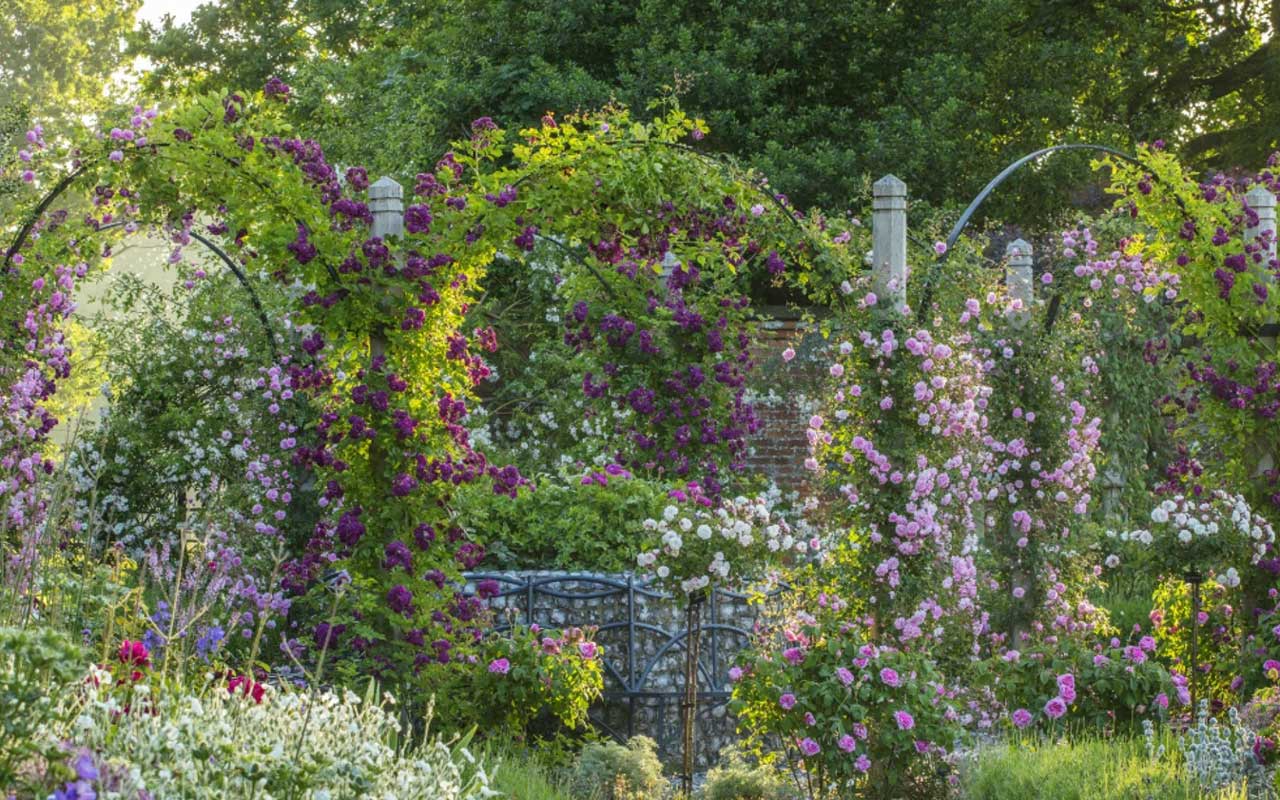Which variety?
Can you tell your hybrid tea from your damask? What’s the difference between a rambler and climber? Does a grandiflora really have bigger flowers? No idea? Well, you’re not alone and all these different terms and varieties seem to be where the rose’s reputation as ‘difficult’ stems from (pun intended!). There are several varieties of rose, which will suit slightly different positions, so let’s look at some of the main ones.
Hybrid Tea Roses
Hybrid teas are the classic ‘rose bed’ rose; often pruned to be statuesque and with luxurious flowers, they can be a showstopper in the garden. Growers regularly breed new varieties, giving us an almost endless choice of colour. By their nature, hybrid teas are classed as Modern Garden Roses, as opposed to some of the wild or heritage varieties. This means they can flower more than once a year, often have larger blooms, usually one per stem, and can be great as cut flowers.
Floribunda
Another popular variety of rose is the Floribunda. Unlike the statuesque hybrid tea, these tend to be ‘shrubbier’ in habit and often have multiple flowers on a stem. As a result, they are often pruned less formally.
Patio roses
We sell a good number of smaller rose varieties, too. We refer to them as patio roses but they will be fine in small gardens or even large pots, so check when you buy, particularly miniature or miniflora roses. Prune fairly hard between December and March to encourage new growth and flowers later in the spring.
Climbers and ramblers
Climbing or rambling roses aren’t really varieties in their own right but rather descriptions of how they behave. For example, some floribunda and grandiflora roses will climb or ramble quite happily if you let them!
But what is the difference between a climber and rambler? Climbing roses tend to have larger blooms on fairly stiff, not overly vigorous stems; most repeat flower (especially if dead-headed regularly and stems are trained horizontally). Climbers are great for more formal settings, such as growing against walls or over obelisks and trellis. Ramblers, on the other hand, have a more vigorous habit, producing greater quantities of smaller flowers. They tend not be repeat flowering. Ramblers often suit less formal positions, like letting them grow into a tree or pergola, or ramble all over a shed.
Climbing roses should be pruned in the winter and tied in to supports if you’re using them at that time. Rambling roses are better pruned immediately after they have flowered, probably in late summer. However, neither type will be seriously harmed if you need to do a little tidying up at other times of the year too!
 Shrub and ground-cover roses
Shrub and ground-cover roses
Once again, these are less varieties of rose and more about their habits. Shrub roses produce flowers in clusters and some varieties can sprawl more than 10 feet in every direction (if you let them). They are particularly hardy to the cold. There are many varieties of shrub roses, perhaps the most notable of which is the David Austin English Rose.
Groundcover or landscape roses are bred to be – perhaps – the best of all worlds: vibrant colour, delicious scent and low maintenance. They can be a great space filler, rarely growing more than three feet tall, and are often continuously flowering through the season. They can be the perfect ‘beginners’ rose.
Antique and historic
There are many varieties of rose which can trace their ancestry back hundreds of years in some cases. Old Garden Roses are double-flowered plants which have been around since at least 1867. Alba Roses date back to around 100AD and will cope with cooler climates. Bourbon Roses were introduced in France in 1817 from crossing two even more historic varieties, Damask and China roses, to combine the velvety petals and heady scent of both. Gallica roses have been used for medicines since around the twelfth century. Centifolia or ‘cabbage’ roses are often used for essential oils.
All of these ancient rose varieties have several characteristics in common. Firstly, their long ancestry usually means they have evolved to be pretty pest and disease hardy. They usually only flower once in a year but they can have the strongest fragrances of all the roses.
Wild roses
We couldn’t finish without mentioning wild roses, also known as species or dog roses. You are unlikely to find them in a garden centre but you may well find them out in the hedgerow. They are distinguishable by their single, five-petalled flowers and they are almost always pink.
General planting tips
Roses generally do well in a sunny spot, sheltered from strong winds. They will prefer relatively free draining soil (adding grit before you plant can help) but do like a rich, organic soil (add some well-rotted manure). Hybrid teas particularly don’t do as well when crowded by other plants (think of the classic rose bed with nothing but roses in it!) so give them space and keep on top of the weeding.
Pests and diseases
Generally, keeping your rose (or any plant) healthy will help to deter most pests and diseases; a plant that is not stressed is better able to stand its ground.
One of the more common rose conditions is black spot, which appears as black spots on the leaves. It doesn’t look particularly attractive but generally does little damage to the plant; just be sure not to compost any affected leaves to reduce the risk of it spreading. Similarly, aphid and greenfly infestations usually aren’t too serious and can often be dealt with by spraying with a solution of soapy water (or encouraging ladybirds).
The RHS has a great guide to dealing with many rose problems here.



 Shrub and ground-cover roses
Shrub and ground-cover roses